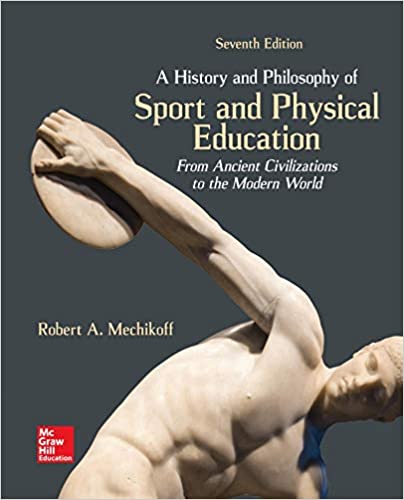Description
Test Bank For A History and Philosophy of Sport and Physical Education 7Th Edition By Robert Mechikoff
A History & Philosophy of Sport, 7e (Mechikoff)
Chapter 2 Sumer, Egypt, China, and Mesoamerica
1) What cultural interests do ancient and modern civilizations have in common?
A) Admiring athletic ability and physical fitness
B) Participating in athletic competition
C) The desire to play
D) All of the answers are correct.
Answer: D
Accessibility: Keyboard Navigation
2) Historians, sociologists, and anthropologists have long noted the significance of physical ability and physical expression. As a result, they have reached which of the following conclusions?
A) The quest for survival during ancient times—and modern time—was and is in some way facilitated in our desire to play.
B) Play was indeed important, but only members of the aristocracy were permitted to play. Children who were not members of the aristocracy were prohibited from engaging in play.
C) The human race evolved not because of anything that physical ability and the expression of play may have contributed but due to mere chance and luck and nothing more.
D) Physical expression and physical ability has no direct or indirect connection to the work of Charles Darwin, who is credited for developing the theory of evolution.
Answer: A
Accessibility: Keyboard Navigation
3) In the ancient world—as it is in the modern world—survival of an individual, community, or nation depended in part on
A) physical prowess and physical fitness of the inhabitants.
B) highly skilled and disciplined warriors and soldiers.
C) a physical education program that provided instruction in traditional military skills, such as endurance running, wrestling, and swimming to name a few.
D) holding athletic competitions that highlighted “combat sports” such as the javelin throw, foot races, archery, and boxing.
E) All of the answers are correct.
Answer: E
Accessibility: Keyboard Navigation
4) According to Johan Huizinga, the author of Homo Ludens, the reason that humans engage in play and related activities is because it is
A) enjoyable and fun.
B) the one activity that separates humans from animals.
C) deeply religious and therefore provides meaning to life.
D) All of the answers are correct.
Answer: A
Accessibility: Keyboard Navigation
5) The Sumerians
A) inhabited an area in the ancient world known as Mesopotamia, which today is known as Iraq.
B) developed cuneiform writing, which revolutionized the way people communicated.
C) developed an intricate political and economic system.
D) engaged in warfare as did most of the other political entities during this time.
E) All of the answers are correct.
Answer: E
Accessibility: Keyboard Navigation
6) The “athletic” Sumerian king who is thought to have ruled during the twenty-seventh century B.C. was
A) Herakles.
B) Gilgamesh.
C) David.
D) Alexander the Great.
Answer: B
Accessibility: Keyboard Navigation
7) The Assyrian warrior-king Assurbanipal
A) was known to lead his troops into battle.
B) was a superb hunter.
C) was honored with odes and citations that demonstrated that in the ancient world, there was a strong connection between sport and religion.
D) claimed to have personally killed 1,000 lions.
E) All of the answers are correct.
Answer: E
Accessibility: Keyboard Navigation
8) Archaeologists excavating the ancient city of Sumer have learned that
A) artifacts uncovered during the Early Dynastic period of Sumerian civilization (3000-1500 B.C.) provide evidence that sports and games were played.
B) combat sports such as boxing and wrestling date from around 2000 B.C.
C) the Sumerians enjoyed fishing and boating.
D) the Sumerians enjoyed playing board games and children played with toy chariots and boats.
E) All of the answers are correct.
Answer: E
Accessibility: Keyboard Navigation
9) According to archeological evidence, which of the following is a view that Sumerians had about the value of the human body?
A) Sumerian kings married the goddess Inanna each year to elevate their physical presence, thus making them “godlike” and ensuring that their bodies and physical attributes had value.
B) The Sumerians paid special attention to the body in matters of personal hygiene because they often used the body as a subject of art.
C) The Sumerians were heavily influenced by Greek thought and culture and held the body in high esteem and featured it—the human body—in their art.
D) Sumerian kings were often portrayed naked in the works of sculptors and artists because they believed that nakedness expressed pride.
Answer: A
Accessibility: Keyboard Navigation
10) Lion hunting was a popular sport for Sumerian rulers because:
A) victors of lion hunting were depicted as athletes in their temples at Abydos and Abu Simbel.
B) victors of lion hunting were rewarded with land as well as rations of beer.
C) it was believed that lion hunting prepared men for the dangers and challenges of war.
D) lion hunting elevated a king’s physical presence and made him “godlike.”
Answer: C
Accessibility: Keyboard Navigation
11) Which of the following was a likely consequence of the royal regatta started by the Egyptian Pharaoh Akhnaton?
A) Development of ulama as a cultural and religious experience
B) Development of the science of medicine
C) Evolution of martial arts
D) Establishment of the sport of competitive rowing
Answer: D
Accessibility: Keyboard Navigation
12) Egypt
A) traces its origins back almost 2,000 years ago where it was a small village along the Red Sea.
B) had monarchs that engaged in sporting activities in order to present themselves to the people as powerful and capable rulers.
C) had monarchs that were ideally able to demonstrate their ability as an athlete, warrior, and hunter.
D) had monarchs that engaged in sporting activities in order to present themselves to the people as powerful and capable rulers. They were ideally able to demonstrate their ability as an athlete, warrior, and hunter.
Answer: D
Accessibility: Keyboard Navigation
13) Which of the following was most likely true of the ancient Egyptians?
A) They built grand palaces, streets, and monuments that were among the grandest in the land.
B) They quite possibly developed the science of medicine.
C) They had a social structure that included the wealthy, common citizens, and slaves.
D) They were superb warriors.
E) All of the answers are correct.
Answer: E
Accessibility: Keyboard Navigation
14) Archaeologists know that the Egyptians
A) enjoyed participating in sporting activities because of the countless artifacts that have been discovered as well as the paintings that have been found in tombs.
B) believed in “life after death” and members of the nobility and the wealthy, who were able to construct magnificent tombs, were buried with items that were to give them pleasure and comfort in the next life. Among these items were sporting implements.
C) were pagans who did not worship any god or gods and, as a result, found no use for physical expression or a need for sports.
D) enjoyed participating in sporting activities because of the countless artifacts that have been discovered as well as the paintings that have been found in tombs. They also believed in “life after death” and members of the nobility and the wealthy, who were able to construct magnificent tombs, were buried with items that were to give them pleasure and comfort in the next life. Among these items were sporting implements.
Answer: D
Accessibility: Keyboard Navigation
15) Wealthy Egyptians
A) enjoyed boating on the Mississippi River.
B) enjoyed flogging slaves in the market.
C) enjoyed swimming in their own swimming pools at home.
D) All of the answers are correct.
Answer: C
Accessibility: Keyboard Navigation
16) In ancient Egypt,
A) the demand for physical labor was never-ending.
B) life was harsh and difficult away from the large cities.
C) individual survival depended in large part on physical fitness, health, and luck.
D) festivals and religious observation provided a break from the harsh physical demands of farming and fishing.
E) All of the answers are correct.
Answer: E
Accessibility: Keyboard Navigation
17) The Egyptians had a reputation
A) for being superb warriors.
B) for being able to mobilize the entire population to serve as slaves.
C) for their humanitarian methods of training their soldiers.
D) for using women and children as front-line soldiers.
Answer: A
Accessibility: Keyboard Navigation
18) Young Egyptian men of the aristocracy
A) enlisted as foot soldiers rather than in the chariot corps.
B) were placed in the barracks where they were physically beaten.
C) became proficient as archers so they would be among the last to face the enemy.
D) None of the answers are correct.
Answer: D
Accessibility: Keyboard Navigation
19) The primary weapon of an Egyptian soldier was the ________.
A) bow and arrow
B) sword and shield
C) slingshot
D) dagger
Answer: A
Accessibility: Keyboard Navigation
20) As far as recreational activities go, the Egyptians enjoyed
A) Greek wrestling, especially the pankration.
B) organized rowing contests on the Ganges river.
C) music, singing, and dancing.
D) All of the answers are correct.
Answer: C
Accessibility: Keyboard Navigation





Be the first to review “Test Bank For A History and Philosophy of Sport and Physical Education 7Th Edition By Robert Mechikoff”